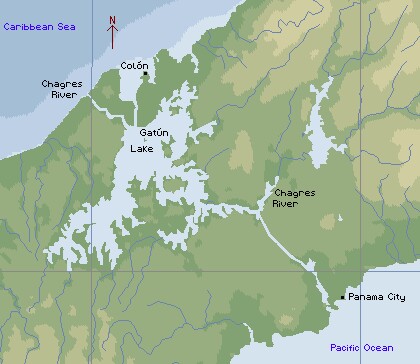
Click on the map to see an enlarged version showing our
actual path through the canal. Note that North is UP
|
Caribbean Landfalls SW Carib Pages Related Pages Panama NewslettersSW Carib Flora/Fauna |
Canal Transit
 Click on the map to see an enlarged version showing our actual path through the canal. Note that North is UP |
Date of Transit: March 22, 2003
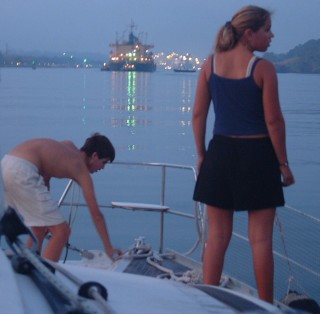 Chris preparing lines for our first lock, 5 AM |
History: The Panama
Canal was created from 1870 to 1914. It had originally been planned as a
sea-level canal from the Pacific to the Atlantic, somewhere in central America.
After many surveys, it was agreed that the only plausible location for such a
canal was Panama.
In 1878 French lieutenant Lucien Wyse, having been awarded a contract
to build a canal from the Columbian government, sold it to Ferdinand de Lesseps, a French
diplomat. Lesseps was determined to build a sea-level canal, but this initial
thought was soon determined to be almost impossible. He was adamant, however,
and kept searching for a way. Meanwhile, one of his chief engineers, Philippe
Bunau-Varilla, formed a new canal company, and the USA was contemplating a canal
somewhere in Central America, possibly in Nicaragua or Panama. Ferdinand de
Lesseps finally admitted he could not complete a canal, and agreed to sell the
concession to the USA. The Columbian government, however, refused permission to
conclude the sale.
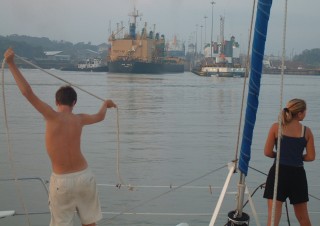 Arranging lines as we approach our first locks |
This, of course, thwarted French, American, and Panamanian interests. As Panama was
already trying to break away from Columbia, Bunau-Varilla, with much to gain
from the sale, asked the US to back Panama when it declared independence from
Columbia. Panama became independent on November 3, 1903. The United States
immediately recognized the new government and prevented Columbian ships that
were attempting to reclaim control from reaching the Panamanian coast.
The first canal
treaty was made on November 18, 1903, between Bunau-Varilla, Panamanian ambassador to
the US, and Secretary of State John Hay. The treaty gave the US "sovereign
rights in perpetuity over the Canal Zone," which included land within 8 km
on each side of the canal, and a right of intervention in Panamanian affairs.
This treaty offered much more to the US than the treaty refused by the Columbians, and
actually was more than Panama wanted to offer. It created friction between the three
countries for decades, and Columbia did not recognize Panama as a legitimate
separate country until 1921.
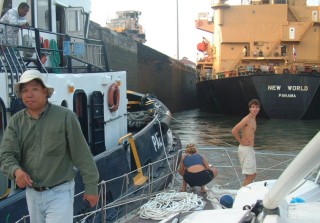 Amanda finishes cleating off the bow lines. Jimmy Wong, our advisor, walking back. |
In 1904, construction on the canal began once again. It was created as a lock
canal, three locks up to the Gatun Lake, and then three more down. Construction
took 10 years, and the first ship sailed through on August 15, 1914.
In 1936, the
Hay-Bunau-Varilla treaty was replaced with the Hull-Alfaro treaty. The USA
was no longer able to use troops outside the Canal Zone, and the annual pay to
Panama for use of the Zone was increased. With the absence of the USA's troops,
the Panamanian army grew more powerful, and in 1968 the Guardia National overthrew the
elected president and took control. Guardia General Omar
Torrijos Herrera became the new Panamanian leader.
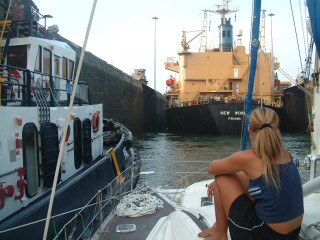 Hang-time once all lines are secure to the tug |
Over the years, the US's control of the Canal Zone became a large conflict between the States and Panama. After years of negotiation, a new treaty was accepted and signed by Torrijos and US President Jimmy Carter in 1977. As a result of this treaty, the US's control of the canal would slowly fade out, with the Panamanian government filling the gaps. On December 31, 1999, Panama assumed complete control of the Canal Zone, although a later treaty granted the US the right of limited intervention as well as the rights to defend the canal beyond the 1999 date, The canal would be to remain open and neutral for all nations, be it peacetime or wartime. For (a lot) more information on the creation of the Panama Canal, read David McCullough's The Path Between the Seas.
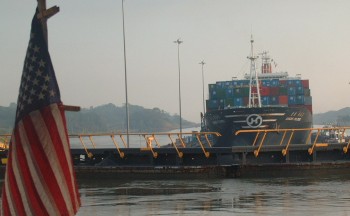 Goodbye Caribbean. Looking down on the Atlantic after the first lock. |
Interestingly enough, the vast majority of Panamanians we met wish the US had never left. The military bases and personnel poured tons of money into the local economy, and most went directly to the people. The locals near the canal recognized this, but the power hungry politicians lobbied hard with those in outlying areas, and the resolution to accept the US withdrawal passed by a slim margin. An example of where things have gone: In 1988 we paid $75 + a $50 refunded deposit to transit in Oriental Lady. In 2003 we paid $600 + an $850 deposit, equivalent to 15% inflation for 15 years! While some of that goes to the government, little gets to the people.
(See also Christopher's essay about the history of Panama, the Canal, and US-Panama relations)
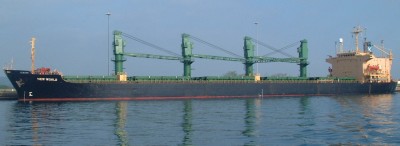 Bulk carrier we locked up with, in Gatun Lake |
Crossing from one ocean to another is such a trip! That you can
do so by sailing through the jungle and then through vast earthworks constructed
during the era of steam makes it even more so. When going through
the canal, all boats by law have to have an advisor, which the canal provides, at least four line
handlers, plus a helmsperson. Not many cruising boats have that many people on board.
You can hire a couple
locals, along with the long ropes you need, but that can get a bit expensive.
What most of the cruisers like to do is strike a deal with another boat - I'll
help you through if you help me through. We preferred the karmic approach.
We helped line-handle two other boats
through before our own date, and Chris and Amanda even got to go as professional
crew, thus earning a half a year's worth of allowance.
We thought that as soon as we hit the
Pacific side we'd be gone, so we started this page before our own transit was
done. Some of the information and pictures come from our 4-6 days
spent as line-handlers, and some come from our own transit on March 22. A special treat
for us was to have our own "imported" line handler --
Jan Reed, a cruising buddy from the 80's, who flew down from Florida to join us through the
Canal. We had hoped to have a leisurely 2-day transit, with time in the Lake,
but alas, it turned out to be a grueling 14-hour day in the hot sun.
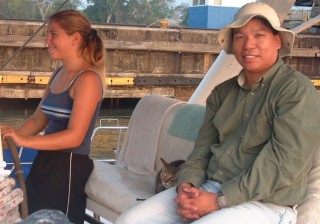 Amanda (& Jimmy) helming through the locks |
(Amanda age 13) For both of
our pre-Ocelot transits our whole family went along with either a couple or another
family, so there were always extra people. The rule of four line handlers and a
helmsperson is only really important if you tie single in the
middle of the locks. If you're rafted up with other boats then
you really only need a couple people on each of the side boats, and only a helmsperson
in the middle, really. But there's always that slight chance you'll be by
yourself, so that's the way it is.
But with all those
extra people, there's a lot of hang time or sitting around being ready to do
something. For example, the first time I was sitting on deck or in the cockpit
with a fender, ready to get it between us and the wall if a rope broke or got
too lose. The second time, we were rafted in the middle of the three boats, and there
was pretty much nothing to do.
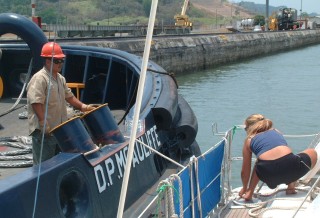 The tug workers were very impressed with Amanda's rope skills |
Most of the time,
however, isn't spent in the locks, where line handlers are essential and people
need to be up on deck. On the beautiful sail through Gatun Lake and the motor
down the long and straight Culebra Cut, it was nice to relax. Eat a little
lunch, drink some soda, take a few pictures, or just sit around enjoying the
breeze, shade, and view.
Both times we helped other boats go through we anchored
the night in Gamboa, just opposite the Chagres River.
We took the dinghy up the river and around through the nooks and crannies. There
were birds galore! We didn't see any crocodiles, which we know live around
there, from the dinghy, but we did shine a light around at night and several red
eyes gleamed back at us. We did take a quick dip in the morning of the
first time we went through, as there were other people swimming and they hadn't
been attacked yet, but we
decided to be prudent the second time. It was nice, however, to pull up a bucket of
fresh water and simply toss it over your head (or your friend's head, as the case
may be).
Funky fact of Panama: There is a city in Panama that was named, before the topic of the railroad even came up, Matachin. It is a place known for the fact that hundreds of Chinese railroad workers suffering from depression ("melancholia"), committed suicide en masse. It is completely coincidental that matachin means "butcher" or "hired assassin" in Spanish, and can also be broken down to "matar" (to kill) and "Chino" (Chinese).
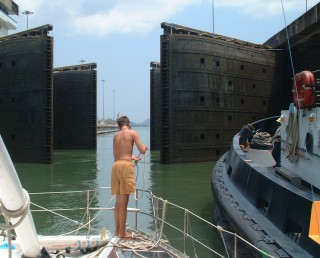 Chris takes in our lines as Ocelot moves away from the tug and the Pedro Miguel locks open |
(Chris age 16) Going through the canal didn't really interest me that much. Frankly, it was only one step up from tying to a dock, as far as I am concerned. However, the canal itself was interesting, and it was fun to go through with other boats, especially Vamp, which has two kids on board. Going through the canal also gave us practice, which is good both for when we take Ocelot through and because, with our experience, Amanda and I got a job taking another boat through, which is pretty easy money.
Somewhat like sailing, the best canal transit is as boring as possible. Excitement is not usually a good thing, and hopefully, the transit is as uneventful as it can be. Frankly, I don't like anything that is really boring, and while I certainly don't want the sort of 'excitements' the canal can give you, sitting there and watching the world go up or down around you is really not my idea of how to spend time. Aside from taking in or letting out the lines, it is a lot like watching paint dry.
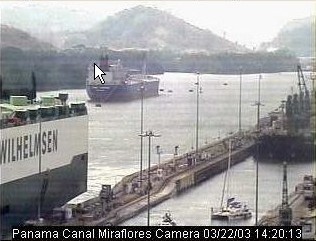 Web-cam of Ocelot entering Miraflores Locks |
That said, I actually didn't mind the transits. Gatun Lake is beautiful, and the locks are very impressive. I was also interested in what the locals had to say about the canal and its changes in recent years. Since most of the time I wasn't needed to do anything, I had lots of time to chat with the pilots and line handlers. I found the history of the canal, and the response of the local populace to the recent changeover from US to Panamanian control, a fascinating subject. I wrote an essay on the surprising stories and research concerning the history of Panama and the Canal's changeover to Panamanian control.
Of course, there is a reality attached to the canal transit that made me very sad. This was the end of the Caribbean, the big line that divided us from everybody and everything on the other side. We are unlikely to ever again see anybody who wasn't making the transit within a few months of us, and I know I will miss the Caribbean islands. True, the whole Pacific is now before us, but before there was always a feeling of going where we want to, forward and back. In the Pacific, there is a long path to follow, and while you can go slower or faster, you can't really return to anything you missed or went through too quickly.
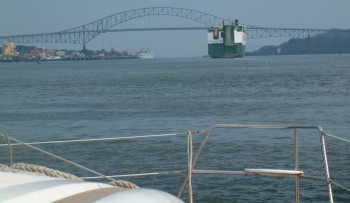 Entering the Pacific and heading for the graceful Bridge of the Americas |
(Jon) Helping other boats through was good fun, and a considerable learning experience. But like sailing, it's very different when it's your own boat, and fairly stress-free on other peoples boats. The net result was that, while I was very interested and attentive while I helped others, I was so busy on our own transit that I barely had time to look around. We used the windless, flat water at the top of the Gatun locks to make a couple of slow circles to calibrate our new autopilot compass (trying to avoid the anchored ships). The anchorage in Colon was so dirty that we didn't like to make water there, so we were low on water and ran the watermaker flat-out (I'd recently installed a second pump) in Gatun Lake. We also used the fresh Gatun Lake water to do several loads of laundry and to scrub the (considerable) accumulated grime of Colon off Ocelot.
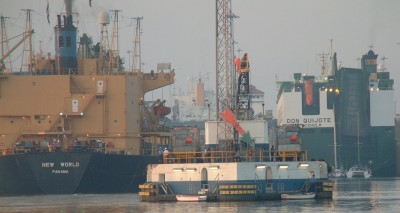 Approaching the first lock, both sides heading toward the Pacific. Note 2 yachts at right. |
We were quite lucky with our Advisor. We'd worked with Jimmy before. He quickly demonstrated that he had Ocelot's best interests in mind, and he was very patient with me. The original program had us rafted to 2 other boats, one of them a catamaran! You can just see them on the right side of the photo, behind the tall green car-carrier. This would have made our raft as wide as 5 normal monohulls, and car-carriers have their propellers close to the surface, leading to lots of turbulence when they move. Finally, one of the advisors on those boats was a real pill who regularly demanded bottled water and special cooked chicken lunches, and threatened boats financially if they didn't comply. So Jimmy called around on his radio and found that the bulk-carrier New World, on the left, had a deep prop and was going through with a tugboat, and we could raft along-side the tug. All our other transits were rafted to other sailboats, so I was a little apprehensive, but it was far easier than I'd expected. We had lots of fenders (tires wrapped in plastic bags) and once the tug got settled on the wall, we just tied up alongside them. Much easier than going through rafted to other sailboats. Jimmy also found us tugboats on the 3 down locks, although it was hardly necessary as there is no turbulence when locking down, so down is much easier than up.
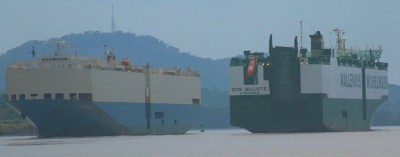 You DON'T want to meet these things at sea! |
For those who haven't seen them before, car-carriers are quite a trip. They look like large, slab-sided boxes perched precariously on the water. They're so high that it seems any good wave would just knock them over, but they seem to survive. I haven't been aboard one, but I understand they can carry over 4,000 cars each. We once watched one pull into Martinique, tie up, let down his ramp (they generally have one on the side & another at the back), offload 200 cars, collect their lines, and leave, all within the space of about half an hour. We shared a lock with the green and white one on the right. I don't ever want to be that close to one of these ugly monsters again. From 100' away, they're very imposing.
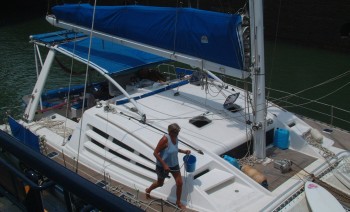 Ocelot from the tugboat - note blue cushions protecting our solar panels aft |
(Sue)
Having been through the canal once in 1987 with
Oriental Lady, I
felt like a sort of veteran. I enjoyed our 4 days spent on other boats as line
handlers, but more for the company than the transit. Because I was still being very careful with my
back I was excused from real work, and got to assist in keeping the crew happy
by making sandwiches, passing out cool drinks, and acting as Spanish interpreter
with the advisors.
Taking
Ocelot through was a bitter-sweet experience. I shared Chris's sadness in
leaving the Caribbean and the many friends we left behind. But I am also very
excited to be facing the Pacific portion of our journey. The transit itself went
really smoothly as we tied to a tug boat each time, meaning the tug did all the
dirty wall work, and we just floated up or down rafted up to him. The tug crew
were always happy for some sweet rolls (we started the transit at 5 AM) or some
cold juice. What they really wanted was sodas. Sorry, no sodas on Ocelot (mean
old parents).
Top Level: Home | Destinations | Cruising Info | Underwater | Boat Guests | Ocelot | Sue | Jon | Amanda | Chris | Site Map | Make a Comment
|
If our information is useful, you can help by making a donation |
Copyright © 2000‑ Contact: Jon and Sue Hacking -- HackingFamily.com, svOcelot.com. All rights reserved.